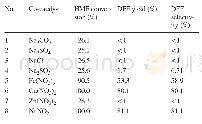《Table 2Typical earth-abundant Ni-based co-catalysts for photocatalytic hydrogen evolution.》
To date,various Ni-based electrocatalysts,including Ni[197,201–204],Ni(OH)x[9,205–218],Ni Sx[219–232],[Ni(TEOA)2]Cl2[233],Ni Ox[234],Ni Bx[235,236],Ni3C[237,238],NiPx[197,239–245],and Ni(dmgH)2[246,247]have been widely utilized as cocatalysts to increase the photocatalytic H2-evolution activity over various organic and inorganic semiconductors[23].Their activities are summarized in Table2.From the table,it should be obvious that a simple combination of a cocatalyst and a semiconductor is involved in many studies.Herein,several original binary systems should be highlighted.For example,in 2010,Xu and coworkers demonstratedfor the first time that 1.2 mol%of NiS modified Cd S NPs showed the highest H2 production rate of 2.18 mmol h–1,with a QE of 51.3%at 420 nm(Fig.14)[248].Subsequently,in 2013,the same group first reported that 1.1 wt%NiS cocatalyst on g-C3N4 could achieve a H2-production rate of 48.2 mmol h–1,corresponding to an apparent quantum efficiency of 1.9%at440 nm(Fig.15)[219].In 2011,Yu et al.found that CdS nano-rods loaded with 23 mol%Ni(OH)2 cocatalyst revealed the highest visible-light H2-production rate of 5085μmol h–1 g–1,with a QE of 28%at 420 nm(Fig.16 (A)and(B)) [212].In 2013,Yu et al.first demonstrated that 0.5 mol%Ni(OH)2-modified g-C3N4 composite photocatalyst exhibited the highest H2-production rate of 7.6μmol h–1(with an AQE of 1.1%at 420nm,which is very close to that of 1.0 wt%Pt/g-C3N4 (8.2μmol h–1)(Fig.16(C)and(D)) [205].In 2014,Cao et al.for the first time reported that a combination of monodispersed Ni2P nanoparticles,as the cocatalyst,and CdS nanorods,as the photosensitizer,was found to result in highly active and stable photocatalytic H2 evolution from an acidic aqueous solution,with a TON of 26,300 for the first 20 h of irradiation(Fig.17)[249].In2018,Li’s group for the first time demonstrated that a hybrid of 1%Ni3C cocatalyst and CdS nanosheets exhibited the highest photocatalytic H2 evolution rates of 357 and 450μmol h–1 in0.25 mol/L Na2S-Na2SO3 and lactic acid,with apparent quantum yields(AQYs)of 7.58%and 8.72%at 420 nm,respectively(Fig.18 (A)and(B)) [238].More recently,the same group reported that 15 wt%Ni3C cocatalyst nanoparticles decorated on g-C3N4 could display the maximum H2-production rate of 15.18mol h–1,corresponding to an AQY of 0.40%at 420 nm[237].These investigations perfectly highlighted the innovation of direct integration of Ni-based cocatalysts,inspired by the novel Ni-based H2-evolution electrocatalysts.However,more attention should be paid to further improving these simple hybrids of cocatalysts and semiconductors for achieving more efficient and durable photocatalytic H2 evolution.Therefore,in this section,the various strategies for improving H2 production over Ni-based cocatalysts will be thoroughly discussed,which should be fully integrated and well designed to maximize the H2-evolution over different cocatalysts.
| 图表编号 | XD0028865300 严禁用于非法目的 |
|---|---|
| 绘制时间 | 2019.03.01 |
| 作者 | 沈荣晨、谢君、向全军、陈小波、江吉周、李鑫 |
| 绘制单位 | 华南农业大学林学与风景园林学院.农业部能源植物资源与利用重点实验室.广东省高校生物质能源重点实验室、华南农业大学林学与风景园林学院.农业部能源植物资源与利用重点实验室.广东省高校生物质能源重点实验室、电子科技大学电子薄膜与集成器件国家重点实验室、密苏里大学堪萨斯分校化学系、武汉工程大学环境生态与生物工程学院、华南农业大学林学与风景园林学院.农业部能源植物资源与利用重点实验室.广东省高校生物质能源重点实验室 |
| 更多格式 | 高清、无水印(增值服务) |
 提示:宽带有限、当前游客访问压缩模式
提示:宽带有限、当前游客访问压缩模式





